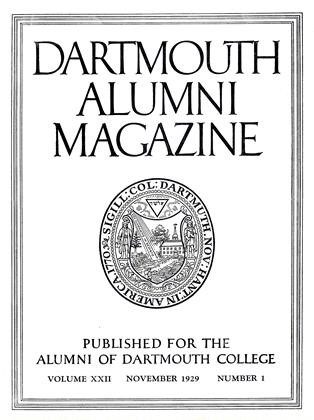MILLSTONE NEEDS AN HISTORIAN
CULVER HALL is coming down, much to the relief of most of us for it has always seemed something of a monstrosity, though a useful monstrosity at times as the departments of Chemistry, English, and Art can testify. And as the work of the erection of a new dormitory in the rear of Culver Hall is now going forward, attention is called to the stir of building and the passing and repassing of trucks by the corner of Culver where the old millstone rests. As in the case of most objects of antiquity the authenticity of the claim to fame on the part of the stone as having once been in the mill where Webster is reputed to have worked is questioned by a scoffing few, but luckily they are outnumbered by the romancers and tradition-lovers. Such scoffers might word the line under the picture of the stone as follows: Probable millstone, alleged to have been brought from the alleged site of the alleged mill on the right bank of Mink brook, and claimed to be one of the stones probably in use during the years when Daniel Webster was in Dartmouth College (for which statement there is evidence) and said to have been in alleged mill at the alleged time when Daniel Webster is supposed to have worked there.
But all this nonsense to the winds. There's evidence in Chase's history about one or two mills on Mink Brook, and the ruins of one of these mills may still be found; in one of these mills arose a fuss in the 18th century that almost caused the removal of the college to New York state. A student went there and was innoculated with small pox during an epidemic, against the orders of the College head, and in the trouble which ensued, Wheelock began to speculate on a new site in a better land. However, that's nothing to do with the Webster tradition. The millstone is a relic and it has the elements of romance and fancy about it. And it now begins a new career of interest in its struggle with the tree.
It is to be hoped that the workmen in tearing down Culver will not destroy the tree. It might be possible to transplant the whole business, the stone around the tree like a collar, to some point in front of the Baker Library.
The millstone from the mill where Daniel Websterworked while in Hanover lies on the ground near the southwest corner of Culver Hall. Into the hole in the middle ofthe stone there fell a few years ago the seed (if that is theproper term) of an elm tree. The tree has increased in sizeuntil at the present time one wonders what will be thefuture of the stone and tree. Will the tree pick up theheavy stone bodily and raise it into the air when the trunkhas grown to the size of the hole, or will the millstone compress the trunk of the tree and kill it? The editor believesthat the crisis of this contest will come in about ten years.He is open to suggestions or wagers.
 View Full Issue
View Full Issue
More From This Issue
-
 Article
ArticleThe Class of 1933
November 1929 By E. Gordon Bill -
 Article
Article"ORIENTATION:" The Opening Address of Dartmouth's 161st Year
November 1929 -
 Lettter from the Editor
Lettter from the EditorEditorial Comment
November 1929 -
 Class Notes
Class NotesCLASS OF 1911
November 1929 By Prof. Nathaniel G. Burleigh -
 Class Notes
Class NotesCLASS OF 1929
November 1929 By Frederick W. Andres -
 Class Notes
Class NotesCLASS OF 1909
November 1929 By Robert J. Holmes







